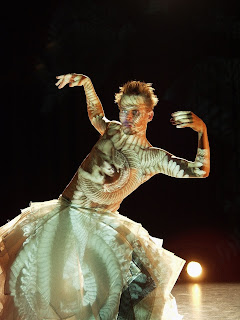SwarmArt: Interactive Art from Swarm Intelligence
Christian J. Jacob, Gerald Hushlak, Jeffrey E. Boyd,
Paul Nuytten, Maxwell Sayles and Marcin Pilat
Paul Nuytten, Maxwell Sayles and Marcin Pilat
2007. 11. 6. Tue.
• Chair : Kyungho Lim
• Panel : Chee Onn, Moonsun Choi, Kiwon Song
• Chair : Kyungho Lim
• Panel : Chee Onn, Moonsun Choi, Kiwon Song
Paper Discussion
1. Introduction
- Behavior of insect
- nindividually : simple or random
- collectively in a swarm : complex and intelligent patterns - Highly coordinated behavior
Swarms of bees, colonies of ants, schools of fish, flocks of birds and fireflies flashing synchronously - SwarmArt
- collaborative project : several computer scientists & an artist - Incorporate elements
- swarm-based system
- video-based image processing - The project originates from the idea that the highly dynamic properties of swarms suggest and enable innovative methods of design, providing new tools to create artwork, such as virtual sculptures built by computer simulated swarms of ants.
2.1 Swarm Intelligence
- AI technique about collective behavior in decentralized, self organized system.
- Simple agents interacting locally with their environment – leads to global behavior.
- No centralize control.
- Example: Ant colony, bird flocking, animal herding, bacteria growth, fish schooling.
2.2 Swarm mind-set
- Being able to understand, such systems would be very beneficial
- Ex 1 : Ants can play music
- Generating music by simulating moves of artificial ants on a graph (vertices represent notes, edges represent transition between notes).
- Ants collectively build sequence of melody in midi. - Ex 2 : Swarms of robots.
Collective & cooperative behavior in swarm robots ie.
In mobile computing, swarm of tri-wheeled robots than can exchange information via wireless architecture.
3. Key factors of SwarmArt
- Simulation of collective behavior and art
- Apply Genetic Programming to evolve - Video interaction
- User interaction = essential part of swarm art for exhibition in museum.
- Implement visual interface uses video camera & computer vision algorithms embedded
for visual interaction
4. Installation of SwarmArt
- SwarmArt 2002 : How it works
- SwarmArt 2003 : colored balls
- SwarmArt 2004
Two cameras took live video from the interaction space, and two displays projected onto the two sides of a corner (Fig. 6a).
Colorful balls and umbrellas invited visitors to play with the objects, thus creating live action for the cameras to capture, which appeared immediately on the projection screens.
To one of these live video feeds projected on the left.
They applied the swarm technique as described above, where the image would seem to decompose and be reassembled by the swarms (Fig. 6b).
On the second screen to the right we displayed randomly selected rectangular sub-sections, taken from the primary display (Fig. 6c).
This created another dimension of composition and decomposition of the live video feed by integrating it into choreographed swarming arrangements.
5. Conclusion
- Symbiotic nurturing partnership
- Apparent disorders become aesthetic curiosities and catalysts for thought
- Weak point
- Not these related constituents position themselves in space
- Not interesting to enough to be considered sculpture - As understanding of swarm process
- To create and share playful sculptural moments in museum installation
Panel Discussion 1 : Interactive Art - Moonsung Choi
- What is fascination of Interactive Art
- completion of conceptual art : not important matrial, mental thing is important.
- interface may be obstacle? - Choice of interactive art work : “void(traffic)”

Panel Discussion 2 : Performing Art - Kiwon Song
- General performing art
- Russel Maliphant’s modern dance
- Samsung's card section as a group performance - Main elements in the performing art for impression
- Elaborate choreography
- Excellent playing of a dancer
- Sound, music, lighting - The performing art with digital media and technology
- "Hunt" : Tero Saarinen
- "Dancing Brush: Six Dances Interacted with Body Brush"

No comments:
Post a Comment